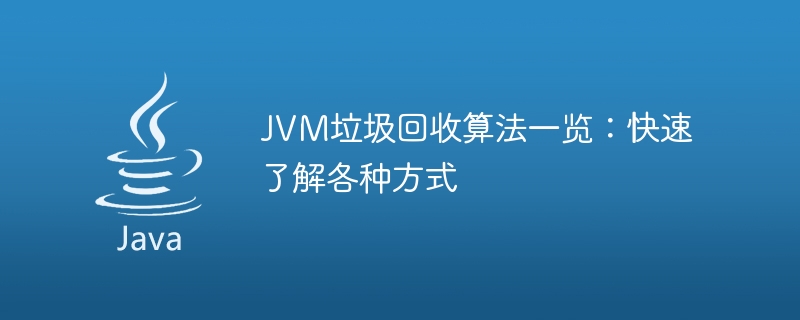Home >Java >javaTutorial >Overview of JVM garbage collection algorithms: Quickly understand the various methods
Overview of JVM garbage collection algorithms: Quickly understand the various methods
- 王林Original
- 2024-02-20 16:39:04949browse

JVM Garbage Collection Algorithm Overview: A quick understanding of various methods requires specific code examples
Introduction:
With the advancement of computer science and software development With rapid development, garbage collection (Garbage Collection) has become an essential part of modern programming languages. As a widely used runtime environment, JVM (Java Virtual Machine) also uses garbage collection algorithms to manage memory and improve program performance and stability. This article will quickly introduce common garbage collection algorithms in JVM and give specific code examples to help readers better understand and apply these algorithms.
1. Reference Counting
The reference counting algorithm is a simple and intuitive garbage collection algorithm. This algorithm sets a reference counter in each object to record the number of times the object is referenced. When the reference count of an object is 0, it means that the object is no longer referenced by other objects and can be garbage collected. However, there is an obvious problem with the reference counting algorithm: it cannot solve the situation of circular references, that is, a circular reference is formed between two or more objects, causing their reference counts to never be 0 and cannot be recycled.
The following is a simple Java code example using the reference counting algorithm:
class Object {
private int referenceCount = 0;
public void addReference() {
referenceCount++;
}
public void removeReference() {
referenceCount--;
}
// 其他方法...
}
// 使用示例
Object obj1 = new Object();
Object obj2 = new Object();
obj1.addReference();
obj2.addReference();
obj1.removeReference();
obj2.removeReference();2. Mark-Sweep Algorithm (Mark-Sweep)
The mark-clear algorithm uses two Garbage collection is performed in stages. First, all referenced objects are marked recursively by starting from the root object (usually the program stack and global variables). Then, after the marking phase, the unmarked objects are useless garbage objects and need to be cleared.
The following is a simple Java code example using the mark-clear algorithm:
class Object {
private boolean marked = false;
public void mark() {
marked = true;
}
public void unmark() {
marked = false;
}
public boolean isMarked() {
return marked;
}
// 其他方法...
}
// 使用示例
Object obj1 = new Object();
Object obj2 = new Object();
obj1.mark();
obj2.mark();
obj1.unmark();
obj2.unmark();3. Copying algorithm (Copying)
The copying algorithm divides the heap memory into two equal parts parts, using only one part at a time. When a certain part of the memory space is full, the surviving objects are copied to another part of the memory, and then the used part is cleared. This algorithm is often used for garbage collection in the young generation.
The following is a simple Java code example using the copy algorithm:
class Object {
// 对象的数据...
// 其他方法...
}
class EdenSpace {
private Object[] objects = new Object[100];
public void copy() {
Object[] newObjects = new Object[100];
int newIndex = 0;
for (Object obj : objects) {
if (obj != null) {
newObjects[newIndex] = obj;
newIndex++;
}
}
objects = newObjects;
}
// 其他方法...
}
// 使用示例
EdenSpace eden = new EdenSpace();
// 将对象添加到空间中
eden.objects[0] = new Object();
eden.objects[1] = new Object();
// 复制存活的对象
eden.copy();4. Mark-Compact algorithm (Mark-Compact)
The mark-compact algorithm is mark- An improved version of the cleaning algorithm. After the marking phase, the algorithm will move the surviving objects to one end and then clear the remaining garbage. This algorithm is often used for garbage collection in the Old Generation.
The following is a simple Java code example using the mark-collation algorithm:
class Object {
private boolean marked = false;
private int position;
public void mark() {
marked = true;
}
public void unmark() {
marked = false;
}
public boolean isMarked() {
return marked;
}
public void setPosition(int position) {
this.position = position;
}
public int getPosition() {
return position;
}
// 其他方法...
}
class OldSpace {
private Object[] objects = new Object[100];
public void markCompact() {
int newIndex = 0;
for (int i = 0; i < objects.length; i++) {
if (objects[i] != null) {
objects[i].setPosition(newIndex);
objects[newIndex] = objects[i];
newIndex++;
}
}
for (int i = newIndex; i < objects.length; i++) {
objects[i] = null;
}
}
// 其他方法...
}
// 使用示例
OldSpace old = new OldSpace();
// 将对象添加到空间中
old.objects[0] = new Object();
old.objects[1] = new Object();
// 标记并整理存活的对象
old.markCompact();Conclusion:
This article quickly introduces a common garbage collection algorithm in JVM: reference counting algorithm, mark-clear algorithm, copy algorithm and mark-sort algorithm, and specific Java code examples are given to help readers better understand and apply these algorithms. In actual software development, choosing an appropriate garbage collection algorithm is crucial, which can effectively improve the performance and stability of the program. At the same time, understanding the principles of these algorithms will help us better understand the working principle of the Java virtual machine and optimize the memory management of the program. I hope this article will be helpful to readers on the JVM garbage collection algorithm.
The above is the detailed content of Overview of JVM garbage collection algorithms: Quickly understand the various methods. For more information, please follow other related articles on the PHP Chinese website!

